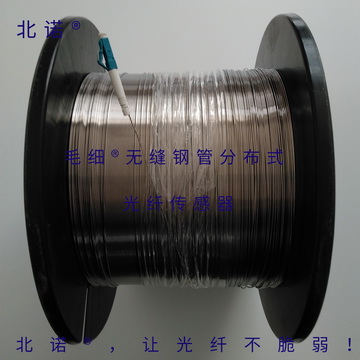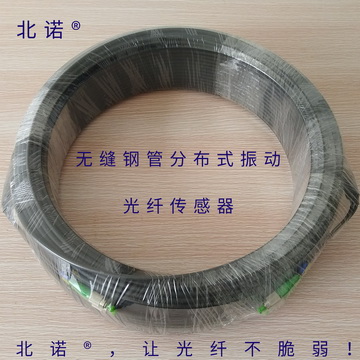This article introduces the different environments of distributed optical fiber sensors and fiber Bragg grating sensors from multiple perspectives, and briefly compares the advantages and disadvantages of fiber Bragg grating sensing technology and distributed optical fiber sensing technology based on Raman scattering, Rayleigh scattering, and Brillouin scattering. Understanding these differences is important to choose the appropriate fiber sensing technology, and select OFSCN's corresponding series of fiber Bragg grating sensors or distributed optical fiber sensors.
Table of Contents:
What are the differences in the application environment between distributed optical fiber sensors and fiber Bragg grating sensors? Which fiber sensing technology should you choose? To answer these questions, you need to understand the advantages and disadvantages of these two fiber sensing technologies.
1. Different Appearance between Fiber Bragg Grating Sensors and Distributed Optical Fiber Sensors
First, let's take a look at the following figures. Figure 1 and Figure 2 show the OFSCN's seamless steel tube fiber Bragg grating sensor (temperature, stress, and strain) of the OFSCN series.
 |
|
Figure 1 |
 |
|
Figure 2 |
Figure 3 and Figure 4 show the OFSCN's seamless steel tube distributed optical fiber sensor (temperature, vibration, etc.) of the OFSCN series.
 |
 |
|
Figure 3 |
Figure 4 |
From the above figures and our previous article "Principle Differences between Distributed Optical Fiber Sensing Technology and Fiber Bragg Grating Sensing Technology,"it is clear that these two fiber sensors are significantly different.
2. Different Length between Fiber Bragg Grating Sensors and Distributed Optical Fiber Sensors
Fiber Bragg grating sensors are generally shorter, usually ranging from 10 centimeters to several tens of meters in length, while distributed optical fiber sensors are generally longer, usually ranging from tens of meters to tens of kilometers in length. Therefore, if your measured object is within 30 meters, fiber Bragg grating sensors are usually the better choice, while if your measured object is over 100 meters, distributed optical fiber sensors are usually more suitable.
3. Different Number of Measurement Points between Fiber Bragg Grating Sensors and Distributed Optical Fiber Sensors
The number of measurement points of fiber Bragg grating sensors is theoretically unlimited but limited in practice. If you use ordinary C-band equipment, considering the economic aspect, the number of measurement points on a single fiber Bragg grating sensor is usually within 20. In contrast, the number of measurement points of distributed optical fiber sensors is much larger, usually ranging from tens of thousands to hundreds of thousands, and the sensing distance is usually longer. Therefore, if you need to measure a large number of points over a long distance, distributed optical fiber sensors are the better choice.
4. The spatial resolution of fiber grating sensor and distributed optical fiber sensor is different.
The measurement position of the fiber grating sensor is small but very accurate. The measurement point is accurately located where the fiber grating is made, and the common fiber grating point is actually a length of 0.5 to 10 millimeters. The measurement points of the distributed optical fiber sensor are larger. Although they are called points, they are actually line segments. For a common Raman scattering device, its point is actually a length of 1 meter.
5. The measurement accuracy and precision of fiber grating sensor technology and distributed optical fiber sensor technology are different.
The fiber grating sensing system generally has good testing accuracy. Using a common C-band device, it can achieve a temperature resolution of 0.1 degrees Celsius and a strain resolution of 0.8 microstrain. The common distributed optical fiber sensing system based on Raman scattering has a measurement accuracy of 1 degree Celsius.
6. The stability of fiber grating sensor and distributed optical fiber sensor is different.
The fiber grating sensor has better long-term stability because the reflection wavelength on which the fiber grating sensing ultimately depends is determined by the grating spacing (grating period), which is relatively stable. The distributed optical fiber sensing ultimately depends on the information such as the intensity, frequency, and phase of the scattered light. The factors that determine the scattered light are the amount of impurities in the optical fiber. With the passage of time, the fiber will gradually age, and the physical quantities measured by the distributed optical fiber sensing system will also change accordingly.
7. Supplementary explanations for points 2-6.
In the second and third points, we did not consider the latest development of fiber grating demodulation technology. In the most advanced equipment, if fiber grating sensors are multiplexed with wave division and time division, fiber grating sensors can also achieve tens of thousands or even unlimited measurement points, and their length can reach kilometer-level.
In the fourth and fifth points, we mainly compared the system composed of equidistant Bragg fiber grating sensors with the system composed of distributed optical fiber sensors based on Raman scattering. It is not appropriate to judge the advantages and disadvantages of fiber grating and distributed optical fiber sensing systems based on this, at least very biased.
In the distributed optical fiber sensing systems based on Rayleigh scattering and Brillouin scattering, the measurement points can also be very small, as small as 1 millimeter, and the measurement accuracy can also be very high, as high as 0.1 degrees Celsius and 1 microstrain. But they will have other problems, such as the matching equipment is very expensive (it is very), or the testing time is long.
8. The difference in principle between fiber grating sensing technology and distributed optical fiber sensing technology can be found in the following text:
光纤光栅传感技术和分布式光纤传感技术在原理上的区别详见下文:
After reading my article, some friends may understand the difference between fiber optic grating sensors and distributed fiber optic sensors, but some friends may be confused by my explanation. If you are confused, I apologize.
In the end, choosing the OFSCN® series fiber optic grating sensors or distributed fiber optic sensors from Beijing Dacheng Yongsheng Technology Co., Ltd. to meet the customer's requirements is a complex and ongoing communication process. Each system has its own advantages and disadvantages, and cannot be simply summarized.
When making a choice, we need to consider various factors such as the investment amount of the sensing system, testing indicator requirements, overall response speed, construction costs, and post-maintenance. If you are unsure, please feel free to contact us via phone or WeChat. We are happy to discuss this topic with you.
Our philosophy is "OFSCN®, make optical fiber stronger!"
